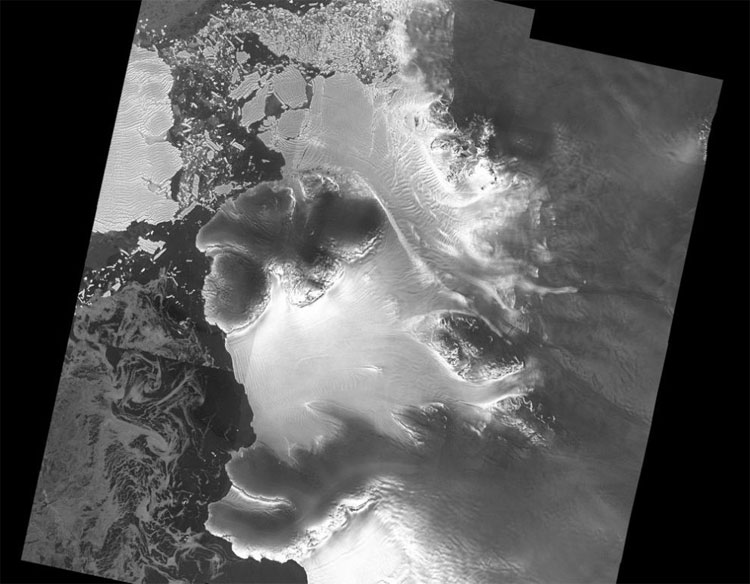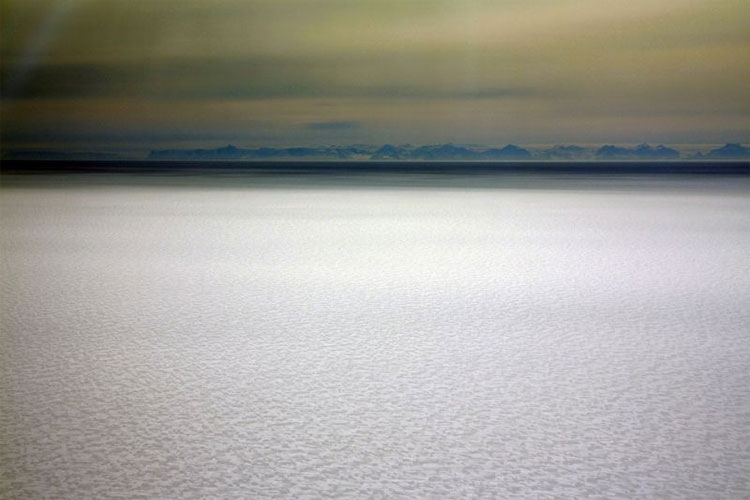Satellites find deep canyons beneath thick ice in Antarctica
A mystical world of upside-down canyons deep beneath the newly discovered Antarctic thick ice.
Researchers have found an internal structure of thick ice in Antarctica, which can then recalculate the thickness of the ice layers as well as their influence on sea level rise. .
Noel Gourmelen, a remote sensing researcher from the University of Edinburgh, said the canyon is in the area of the Dotson ice sheet on the Antarctic western ice shelf. The emergence of this space made 4 billion liters of fresh water from the Antarctic continent spill out through the South Ocean.

Dotson ice shot photos from ESA's Sentinel-1 satellite.The researchers found a wide canyon beneath the ice.(Photo: Copernicus Sentinel data (2017), A. Hogg / CPOM).
According to the European Aeronautics Agency (ESA), the strong division of the ice layers has taken place on a large scale and in a bad degree. To find out, Gourmelen and his colleagues used data from ESA's CryoSat and Copernicus Sentinel-1 satellites to learn about the world beneath the ice shelf in Antarctica.
Both satellites use radar techniques to measure the thickness and momentum of the ice layer. The team used observable data and showed that at the Dotson ice floor there was a 50km wide crack, extending towards the Marie Byrd coast.
'We found small changes in the height of the place through CryoSat's data and about the movement speed of the Sentinel-1 satellite observations, realizing that the melting is uneven, but Gourmelen said he concentrated on a 5km long trench and ran 60km below the ice surface .
The canyon underneath the ice can be formed by relatively warm water of the ocean - about 1 degree Celsius - moving clockwise and facing upwards, due to the planet's rotation.

The top surface of the Dotson ice floor, looks smooth but below is a huge empty space.(Photo: N. Gourmelen).
'We think that the warm water model that enters these ice layers has been going on for about 25 years, based on observations from satellites that show the change in this area of Antarctica' , he added.
At this time, warm water flowed deep into the ice floor at a depth of about 200km and was about 15km wide. This groove extends in depth each year to about 7 meters.
'When fissures are formed on the inside, they will grow further into cracks and spread to the ground, causing the surface to sink and hence melting ice on the surface will occur faster and focus on low subsidence , ' he said in the study.
After this study, Gourmelen and his team will expand the study to the rest of the ice shelves of Antarctica, and beyond, other parts of the continent.
- Mysterious creatures exist under 740m thick ice in Antarctica
- Find a large valley with the Grand Canyon
- Antarctica is rising
- Telescope glass researches dark matter
- Accurate fall point of German satellites
- See the creature in the depths of 180m under the ice in Antarctica
- The greatest canyon in the world hiding under the ice in Antarctica?
- Robot Antarctic explorer
- Finding fish and shrimp living under thick ice in Antarctica
- China decided to find extraterrestrial life
- Find the answer to Antarctic paradox
- Strange sea creatures in Antarctica
 'Fine laughs' - Scary and painful torture in ancient times
'Fine laughs' - Scary and painful torture in ancient times The sequence of numbers 142857 of the Egyptian pyramids is known as the strangest number in the world - Why?
The sequence of numbers 142857 of the Egyptian pyramids is known as the strangest number in the world - Why? History of the iron
History of the iron What is alum?
What is alum? Plan to build giant canopy over Antarctica has problems
Plan to build giant canopy over Antarctica has problems  Why does ice stick to your hands when you hold it?
Why does ice stick to your hands when you hold it?  NASA releases ice map on Mars
NASA releases ice map on Mars  After 389 days in the Arctic, costing more than $160 million, hundreds of scientists brought back bad news: What was it?
After 389 days in the Arctic, costing more than $160 million, hundreds of scientists brought back bad news: What was it?  650,000-year-old 'gateway to the underworld' discovered in Siberia
650,000-year-old 'gateway to the underworld' discovered in Siberia  How to explain the strange ice circle that rotates like a time-travel door?
How to explain the strange ice circle that rotates like a time-travel door? 